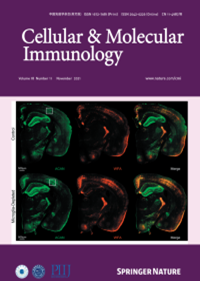FXR protects against neonatal sepsis by enhancing the immunosuppressive function of MDSCs
IF 19.8
1区 医学
Q1 IMMUNOLOGY
引用次数: 0
Abstract
Myeloid-derived suppressor cells (MDSCs) play a protective role against neonatal inflammation during the early postnatal period. However, the mechanisms regulating neonatal MDSC function remain to be fully elucidated. In this study, we report that the bile acid receptor farnesoid X receptor (FXR) acts as a positive regulator of neonatal MDSC function. The FDA-approved FXR agonist obeticholic acid (OCA) protects against neonatal sepsis in an FXR-dependent manner. Genetic deficiency of FXR impairs the immunosuppressive and antibacterial functions of MDSCs, thereby exacerbating the severity of neonatal sepsis. Adoptive transfer of MDSCs alleviates sepsis in both Fxr−/− and Fxrfl/flMrp8-Cre+ pups. Mechanistic studies revealed that Hif1α, a well-established regulator of MDSCs, is a direct transcriptional target of FXR. In patients with neonatal sepsis, downregulation of FXR and HIF-1α in MDSCs was observed, which was inversely correlated with clinical parameters. These observations demonstrate the importance of FXR in neonatal MDSC function and its therapeutic potential in neonatal sepsis.

FXR通过增强MDSCs的免疫抑制功能来预防新生儿脓毒症。
髓源性抑制细胞(MDSCs)在出生后早期对新生儿炎症起保护作用。然而,调节新生儿MDSC功能的机制仍未完全阐明。在这项研究中,我们报道了胆汁酸受体法内甾体X受体(FXR)作为新生儿MDSC功能的积极调节因子。fda批准的FXR激动剂奥比胆酸(OCA)以FXR依赖的方式预防新生儿败血症。FXR基因缺失会损害MDSCs的免疫抑制和抗菌功能,从而加重新生儿败血症的严重程度。在Fxr-/-和Fxrfl/flMrp8-Cre+幼犬中,过继性转移MDSCs可减轻脓毒症。机制研究表明,Hif1α是一种成熟的MDSCs调节因子,是FXR的直接转录靶点。在新生儿脓毒症患者中,观察到MDSCs中FXR和HIF-1α的下调,其与临床参数呈负相关。这些观察结果表明FXR在新生儿MDSC功能中的重要性及其在新生儿败血症中的治疗潜力。
本文章由计算机程序翻译,如有差异,请以英文原文为准。
求助全文
约1分钟内获得全文
求助全文
来源期刊
CiteScore
31.20
自引率
1.20%
发文量
903
审稿时长
1 months
期刊介绍:
Cellular & Molecular Immunology, a monthly journal from the Chinese Society of Immunology and the University of Science and Technology of China, serves as a comprehensive platform covering both basic immunology research and clinical applications. The journal publishes a variety of article types, including Articles, Review Articles, Mini Reviews, and Short Communications, focusing on diverse aspects of cellular and molecular immunology.

 求助内容:
求助内容: 应助结果提醒方式:
应助结果提醒方式:


